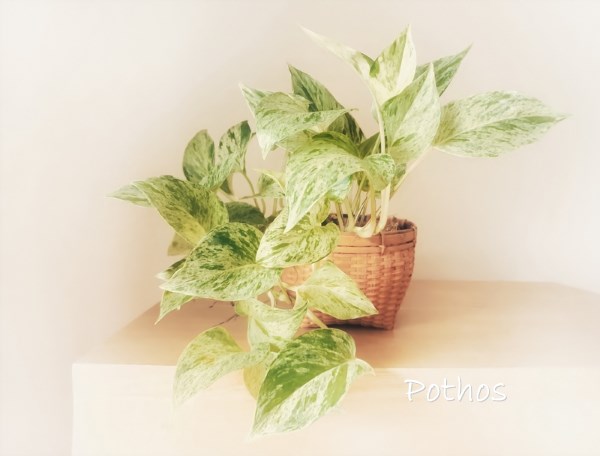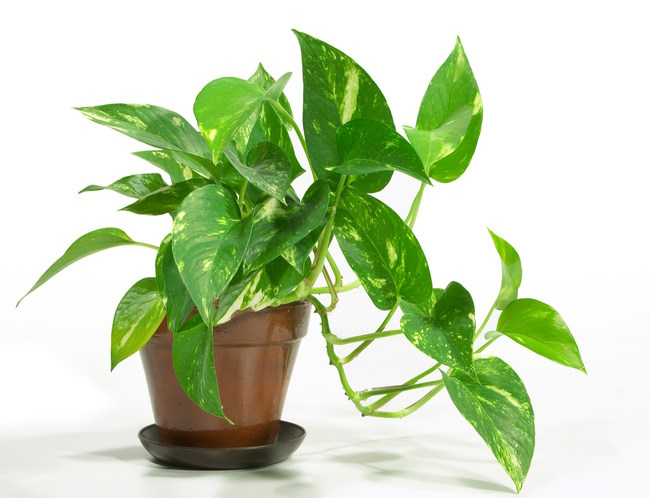Golden Pothos or Devil's Ivy
Botanical Name: Epipremnum aureum
Extremely easy to grow, pothos is a popular house plant well known for its long, trailing stems that can grow to 8 ft (2.4 m) or more.
Cut stems back a couple times a year to keep the plant bushy and full. Cutting right after a leaf node (the place where the leaf is attached to the stem) will encourage the stem to branch out, giving you a fuller plant.
Glossy, heart-shaped leaves emerge green and become variegated with yellow or white. Although this plant tolerates low light well, its leaves may lose their variegation. Pothos will look its best in moderate or bright light. It makes an excellent office plant because it grows well under fluorescent lights.
Air-Cleaning Plant
Pothos is one of the best plants for removing formaldehyde in the air that comes from carpet and other materials in our homes. Beautiful, low-maintenance, and cleans the air. What's not to love?
Show off those beautiful trailing stems in a hanging planter.
Or you can train it to climb. A tree-climber in its native tropical habitat, Epipremnum aureum has aerial roots that can be trained to climb a moss stick or trellis. Use florist wire to hold the vines in place while they grow and wrap themselves around the support.
Repot in spring as needed. You can control its growth by cutting the vines back and trimming up to a third of its roots. Pot it in the same size container if you want to keep it small.
Is pothos poisonous? Yes. According to the ASPCA, this plant contains calcium oxalates, which is toxic to cats and dogs. If eaten, it can cause severe burning of the mouth, tongue and lips, excessive drooling, vomiting and difficulty swallowing. If your pet has eaten Epipremnum aureum and shows any signs of illness, contact your veterinarian immediately.
 Pothos 'Marble Queen' is eye-catching. Photo Credit © Nalin Prutimongkol
Pothos 'Marble Queen' is eye-catching. Photo Credit © Nalin PrutimongkolPothos Problems and Cures
Leaves are mostly green. Leaves will lose their variegation when they don't get enough light. Keep your plant where it will be exposed to bright, indirect sunlight. If your plant is unfurling new leaves that are solid green, don't worry. That's normal -- they'll become variegated as they age.
Stems are leggy with few leaves. Stems that are allowed to grow longer than 4 ft (1.2 m) often shed most of their leaves near the base of the plant. It's a good idea to trim off long stems once in a while to keep pothos leafy and full. Stems that are mostly bare can be cut off at the soil level.
Wilted leaves. Wilting is caused by dry soil. Although this plant will quickly bounce back after a good drink, water regularly.
Yellow leaves and/or stems. Overwatering is about the only thing that will kill Epipremnum aureum. Allow soil to dry out a bit between waterings. Are the stems yellow and mushy? That's a symptom of root rot. Your plant may be too far gone. If any of the stems are still green and healthy, propagate stem cuttings for new plants and discard the dying plant and soggy soil.
Fungus gnats love wet peaty potting mixes. Look for these tiny black fly-like insects crawling on the soil. Find out how to get rid of fungus gnats here.
Epipremnum Aureum Buying Tips
Choose a plant based on your preference because they're all easy to grow. 'Golden Pothos' (shown at bottom) is a popular cultivar variegated with yellow. 'Marble Queen' is handsomely white marbled. 'Neon' has bright yellow-green leaves. N' Joy is generously splashed with white. 'Pearls and Jade' is boldly edged with white.
 Golden pothos trails several feet, making it an ideal shelf plant. Image © vspn24 | istock
Golden pothos trails several feet, making it an ideal shelf plant. Image © vspn24 | istockPothos Care Tips
Origin: Solomon Islands
Height: Vines trail to 8 ft (2.4 m) or longer
Light: Low light to bright light. No direct sun, which will burn foliage. Although pothos will tolerate low light, it will have more leaves and better variegation if kept in bright light. Long spaces between leaves indicate pothos is not getting enough sunlight. This plant thrives under fluorescent light, making it an ideal office plant.
Water: Allow the top 1-in (2.5 cm) of soil to dry between waterings. Use a pot with a drainage hole to prevent soggy soil. Overwatering will cause leaves to turn yellow and fall off.
Humidity: Average room (40% to 60% relative humidity). Brown leaf tips are caused by dry air. Discover easy ways to raise the humidity for your house plants.
Temperature: Average to warm 65-80°F/18-27°C year-round.
Soil: Good-quality all-purpose potting mix
Fertilizer: Feed every 2 weeks spring through fall with a balanced water-soluble fertilizer diluted by half. In winter, feed monthly.
Propagation: Stem tip cuttings root easily in water or moist perlite or vermiculite. Cut a 4-6-inch stem tip with a couple leaves attached. Cut just after a node (a place where a leaf is attached to the stem) because the node contains cells that will grow roots. Pothos cuttings take at least 4 weeks to root.


